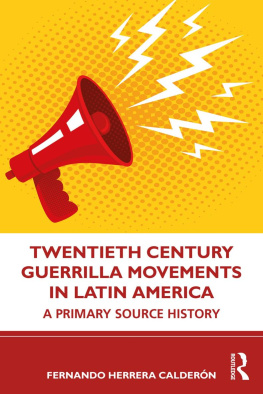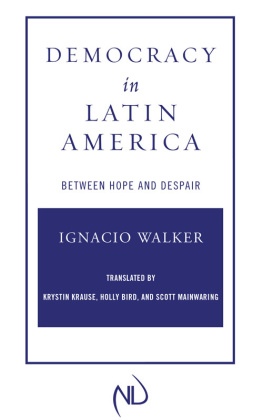Designed by C. H. Westmoreland
Typeset in Trajanus and Trump Mediaeval by Keystone Typesetting, Inc.
Preface
WORDS, FIRST OF ALL, OF GRATITUDE. Translating a text of history from Spanish to English is never an easy task. As Emilia Viotti da Costa, who courageously decided to absolve a similar task by herself, eloquently commented in the Preface to her The Brazilian Empire: Myths and Histories (1985), The real problem was how to convert a Brazilian prose that is more suggestive than precise, full of long sentences, often written in the passive voice... into the short and assertive sentences of the American style. In the case of my Histoha Contempornea de Amrica Latina, the problem was compounded because although the book has found its main use in university courses in Latin American history, it had been written with a different audience in mind: those members of the general public who might be attracted to it by informed curiosity for things Latin American. Trusting that the readers would shareto quote again Emilia Viottithe same assumptions, the same codes, and the same anxieties and perplexities that underlay my explorations, I felt even more free to do full justice to the nuances, the interconnections, and the complexities present in every historical process. Something more than a translation was needed to achieve the metamorphosis of the almost idio-syncratically Spanish American text that resulted from my efforts into a book capable of satisfying American students demands for clear answers to their precise questions. With reckless generosity, Professor John Charles Chasteen took time from his heavy and exciting intellectual and academic agenda to undertake the difficult task of translating and editing the text with that goal in mind. As a result of his effort, The Contemporary History of Latin America now reaches the English-reading public as a differentand I hope betterbook than the one known by the readers of the original Spanish version and other translations. For thisand for the good grace with which he entertained (within reason) my pleas for the text that underwent a not always painless metamorphosisI shall be forever grateful.
Except for the Epilogue, rewritten for the present edition, and for the Bibliographical Essay, prepared especially for it, this is an edited translation of the enlarged thirteenth Spanish edition published in 1990.
Tulio Halpern Donghi
Berkeley, 1993
TRANSLATORS PREFACE
FOR A QUARTER OF A CENTURY, Tulio Halpern Donghis Historia Contempornea de Amrica Latina has been the most influential and widely read general history of Latin America in the Spanish-speaking world. Most historians of the region already know its fine-grained interpretation, unparalleled in breadth and ever attentive to the paradoxes of Latin American reality. The special purpose of this English-language version, then, is to make a landmark of Latin American historiography available to a totally new readership.
To produce a book that would read as though originally written for an English-language audience, the transformations of the Spanish text have exceeded those normally indicated by the term translation, extending beyond lexicon and syntax to prose conventions and addressing needs specific to new readers who possess less background knowledge of Latin America. Thus, the lead story has sometimes been highlighted more vigorously than in the original, which assumed prior familiarity with it, and some matters formerly left implicit have been made more explicit. In addition, a general streamlining occurred as the prose was recast using the shorter sentences and the patterns of paragraphing that are conventional in contemporary English usage. The paragraphs of the original interlock conceptually like links in a chain, a technique involving complex sentences that often reiterate or summarize an earlier idea before proceeding to elaborate on it, while the sentences of the English-language version follow one another more like beads on a string. In this sense, The Contemporary History of Latin America has been edited as well as translated. It would have been impossible to undertake such an ambitious task without the benefit of careful monitoring by the author, and I am grateful for his close cooperation throughout the process.
Something is inevitably lost in translation. In this case, the richness of nuance characteristic of the original, its relentless exploration of internal contradictions, nested one inside another, have occasionally been muted by the heightening of primary emphasis and the application of greater forward momentum. Consequently, this translation cannot substitute for consultation of the original on matters of particular interest to specialists. On the other hand, thousands of new readersmany of whom might have been frustrated by a more traditional sort of translationcan now explore a book that has exercised incalculable influence over Latin Americans understanding of their history.
John Charles Chasteen
Chapel Hill, 1992
PROLOGUE TO THE THIRTEENTH EDITION
FIRST PUBLISHED IN 1967, The Contemporary History of Latin America has required a new edition to include what have been, for Latin America, two very long decades since that year. After the process of revision began, it quickly became clear that updating was not enough. These twenty years have thrown a different light on Latin American history, especially on the last half century. Therefore, while I made few changes in the first five chapters of the original version, I decided to rewrite totally the materials covering the period since the crisis of 1929 and to add two more chapters beginning with the Cuban Revolution. The perspective of the last two decades has brought the period of Latin American history after World War II into sharper focus, and, of course, the period during which I first wrote also looks different in retrospect.
The Zeitgeist of the 1960s is no longer with us. Gone is much of the optimism created by the great postwar prosperity of the developed world. Gone, too, is some of the impatience then awakened in peripheral countries unable to participate in that prosperity. More than we realized at the time, that optimism underlay both our diagnoses of past ills and our proposed remedies for them. During the 1960s, developmental theories and opposing revolutionary analyses alike rested on assumptions about a happier future seemingly almost within reach. Although neither of those rival faiths dominated this














